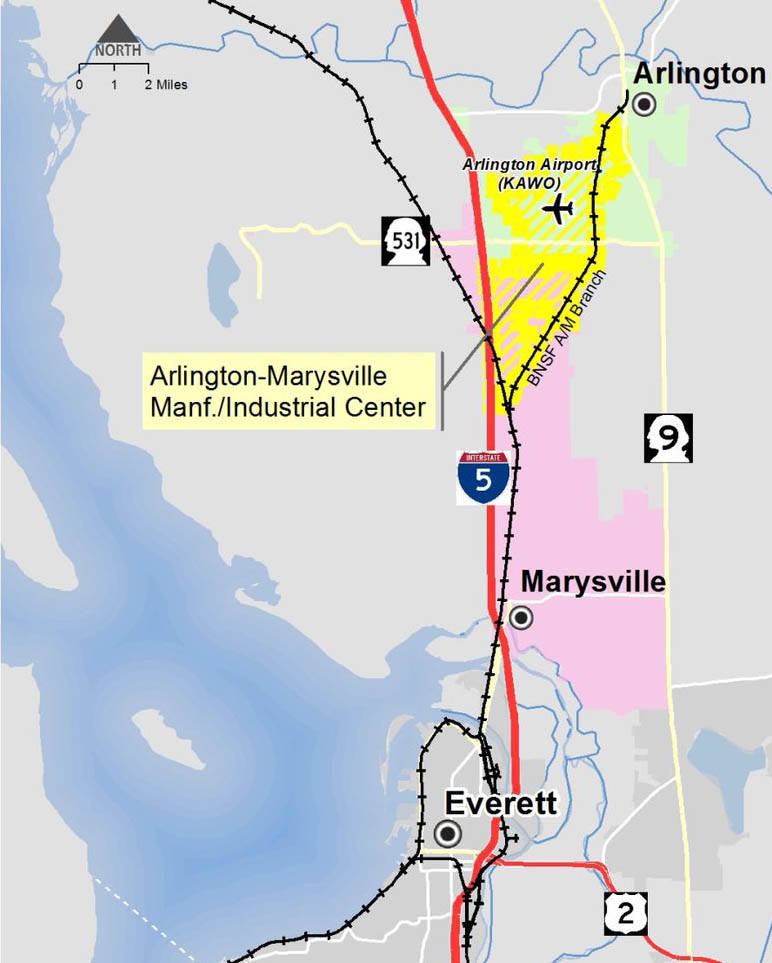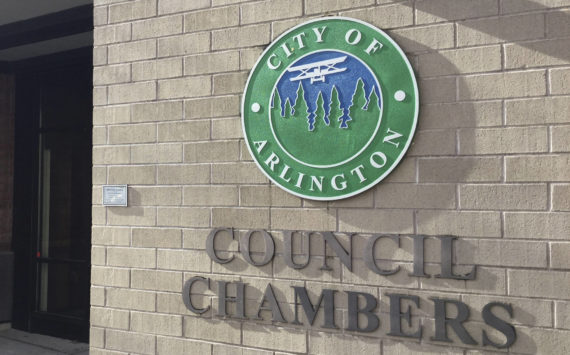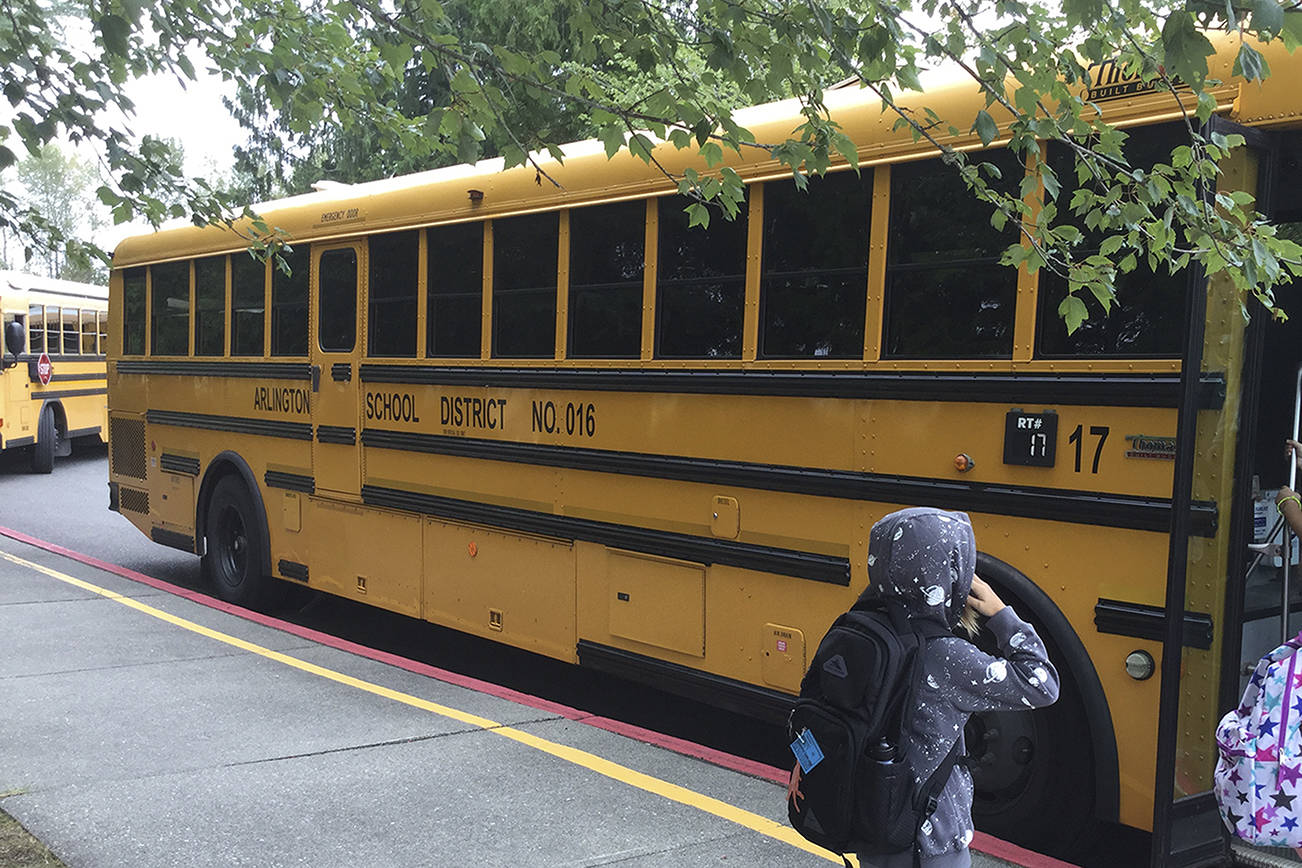SEATTLE – The proposed Arlington-Marysville Manufacturing-Industrial Center should clear a crucial step for recognition when a regional governing board puts it to a vote in early January.
Puget Sound Regional Council’s Growth Management Policy Board last week postponed voting to give board members more time to review extensive policy framework updates and guidelines that relate to MICs, countywide centers in Snohomish, King, Pierce and Kitsap counties, regionally-designated mixed use centers and military installations.
Pending approval by the policy board, the MIC decision would move on to the PSRC Executive Board for action later in the month, starting the clock where the cities could actually apply for MIC designation, a process that could last into summer.
For city leaders in Arlington and Marysville who have worked together with Snohomish County to create a diversified manufacturing, industrial and advanced technologies center clustered around Arlington Airport and the Smokey Point area, a “yes” vote would have made a great early Christmas present.
However, waiting a little longer won’t slow the zeal that the cities have already demonstrated to lay the groundwork ahead of the proposal.
“I’ve got my hopes up that we’ll get to the vote next month,” said Arlington city council member Jan Schuette, who serves on the policy board and has tracked the MIC’s progress over the past few years. “We came very close (to a vote at the last meeting).”
The Arlington-Marysville MIC spans about 4,000 acres, fairly evenly split between the cities, with a little more on the Arlington side. More than 1,700 of those acres are considered ready to develop because they are vacant, could be redeveloped or are only partly occupied, city officials said.
Currently, there are about 5,300 jobs in the center, but it could become home to between 10,000 and 25,000 jobs by 2040. The manufacturing-industrial center would become only the county’s second designated center focused on manufacturing and industry.
Why should residents care if these kinds of jobs land here instead of somewhere else? A key reason is that these types of corporations pay a lot higher wages than service-sector jobs and don’t always require a college degree.
A PSRC study on industrial lands found the annual earnings from industrial jobs averaged $80,000 in 2012. By comparison, the average wage across central Puget Sound in 2012 was $59,700. Retail trade, one of the largest segments of the regional workforce, only averaged $36,300 per year.
“Encouraging new manufacturing businesses to locate and expand in the area will bring jobs to our cities and strengthen our economy,” Marysville Mayor Jon Nehring said.
Arlington Mayor Barb Tolbert said that “having family wage jobs close to home helps alleviate traffic congestion and adds to our families’ quality of life.”
The state legislature gave Marysville and Arlington a valuable tax break to help attract businesses to the industrial area. The cities can exempt companies from paying a portion of property taxes if they create a minimum of 25 jobs that pay at least $18 an hour.
The two cities in September were awarded $100,000 in state grant funding for public infrastructure and economic development studies focused on the future MIC. Meantime, Comcast is already at work building a $1.5 million telecommunications network that will deliver high-speed fiber connectivity essential to today’s business sector, Snohomish County PUD is upgrading substations to further enhance local power access, and Community Transit is prepared to expand commuter routes as the center evolves.
Some may wonder what all the MIC designation hype is about when the cities already have much of the industrial-zoned property, an airport and a growing industrial sector already in place, not to mention a head start on stormwater detention, road improvements and other public services.
The answer is simple.
“For cities, it’s an incentive,” PSRC senior planner Liz Underwood-Bultmann said. “MIC designation brings prioritization for transportation funding, and gives cities a leg up on regional funding to help with infrastructure needs that support manufacturing and industry activity.”
Additionally, she said, “It raises the profile of the area, and provides regional status for marketing purposes.”
The Arlington-Marysville proposal is one of two new MICs – the South Tacoma Industrial Area is the other – and the board has a full plate of planning policy items that also includes decisions on regional growth centers, countywide centers and military installations, all tied to VISION 2040.
In all, the four-county region has 29 regional growth centers where business activity is clustered and prominent, and nine designated regional manufacturing-industrial centers where intensive industrial and commercial activity dominates, or is planned.
If Arlington and Marysville residents want a close-to-home example of a thriving MIC in action, they need look no further than Paine Field/Boeing in Everett. The center, designated in 2002 and Snohomish County’s only one, comprises 4,241 acres (6.6 square miles), of which about 1,300 acres is airport property, 1,000 acres owned by Boeing, and total employment of 42,412 people.
A more fitting comparison for Arlington and Marysville’s is the Sumner-Pacific MIC in Pierce County that gained its status in April 2016, and the last center granted such by PSRC in the last decade. They share many similar characteristics to the Arlington-Marysville area including appropriate zoning, buildable lands, lease space, environmental conditions, industry mix and economy, public services, access to rail, highways and ports, and transportation challenges related to I-5 and state feeder highways.
Sumner goes to great lengths to maintain its small-town USA look and feel, but for industry, it’s a distribution hub and warehouse paradise served by three freeways, Sounder commuter trains and located between the ports of Seattle and Tacoma.
Sumner-Pacific’s MIC is a 2,100-acre industrial area in the two cities with more than 14,000 regional jobs, and located on SR 167.
Key businesses in the area include distribution centers for Amazon, REI, Costco, Target and Kellogg’s, as well as Keurig Green Mountain Coffee Roasters, GKN Aerospace, AIM Aerospace and Composite Solutions.
Sumner landed Cummins Sales and Service after the diesel and natural gas engines manufacturer opted to construct a new building instead of remodel its Renton facility. The 55,660-square-foot facility includes 25 service bays for vehicle maintenance, too, and opened another facility in Everett in October.
For Sumner, MIC designation had less to do with making the area attractive for new business.
“Attracting business was never the problem,” Sumner spokeswoman Carmen Palmer said. The city’s historical base of warehousing, international headquarters sited there, and its location have kept industry thriving.
What Sumner gained through MIC designation are some of the same advantages that Arlington and Marysville are seeking.
“We gained better priority for transportation grants to address our own issues revolving around truck routes and commuter traffic – it’s a nightmare, and we got more status to better tell the story of who we are,” Palmer said.







